河北地下水超采情势及种植结构调整对策的经济分析
河北省地下水超采综合治理方案

河北省地下水超采综合治理方案【摘要】河北省作为中国重要的经济和人口中心之一,长期以来地下水资源的开采已经达到了严重超过补给能力的程度。
为解决这一问题,本文提出了一套综合治理方案,旨在保护河北省地下水资源的可持续利用。
【引言】地下水是河北省重要的水资源之一,对农业、工业和饮用水供应起着至关重要的作用。
然而,由于近年来人口增长、城市化进程以及工业活动的加剧,导致地下水超采现象严重。
为了保护地下水资源,在此提出河北省地下水超采综合治理方案。
【问题评估】地下水超采已经造成了一系列问题,包括地下水位下降、地表塌陷、土壤盐碱化等。
这些问题严重影响了当地生态环境和经济发展。
河北省地下水超采的主要原因有:不合理的地下水开采方式、缺乏合理的管理和监督、没有有效的补给措施等。
【治理目标】该综合治理方案的主要目标是实现地下水资源的可持续利用,保护当地的生态环境和经济发展。
具体目标包括:提高地下水的补给能力、控制地下水开采量、恢复地下水位,减少地表塌陷和土壤盐碱化等。
【治理措施】1. 制定科学合理的地下水开发利用总量控制方案:根据地下水资源的补给能力和需求量,制定合理的地下水开采总量,并且实施动态调整措施。
2. 加强地下水管理和监督:建立完善的地下水管理制度,加强对地下水开采的监督和管理,严禁违法超采行为。
3. 推广节水技术和设施:加大对农业、工业和居民的节水技术和设施的推广力度,提高用水效率。
4. 发展替代水资源:开发利用其他替代水资源,如污水处理再利用、雨水收集利用等。
5. 加强地下水补给措施:采取合理的水源补给措施,包括人工引水、水库蓄水、人工降雨等。
6. 加强地下水保护区建设:划定并严格执行地下水保护区范围,限制污染源,保护地下水质量。
【实施计划】1. 制定详细的治理方案,明确各项治理措施的实施时间、责任部门和预算。
2. 设立地下水监测系统,实时监测地下水位和地下水质量,及时发现和解决超采问题。
3. 加强科研和技术支持,利用新技术和方法提高地下水利用效率和补给能力。
河北省地下水超采区治理措施探讨
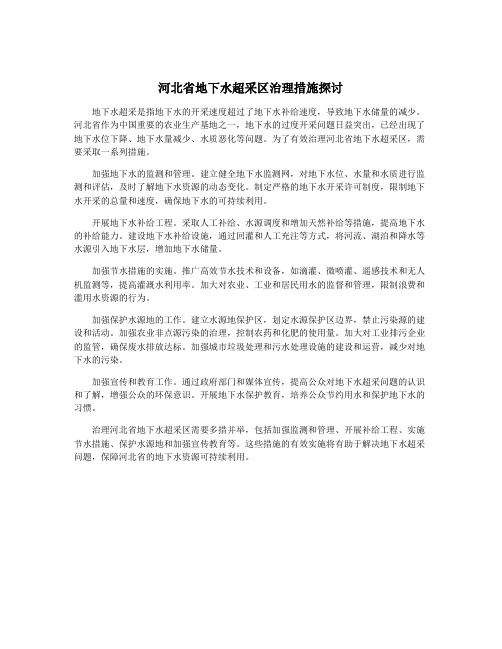
河北省地下水超采区治理措施探讨地下水超采是指地下水的开采速度超过了地下水补给速度,导致地下水储量的减少。
河北省作为中国重要的农业生产基地之一,地下水的过度开采问题日益突出,已经出现了地下水位下降、地下水量减少、水质恶化等问题。
为了有效治理河北省地下水超采区,需要采取一系列措施。
加强地下水的监测和管理。
建立健全地下水监测网,对地下水位、水量和水质进行监测和评估,及时了解地下水资源的动态变化。
制定严格的地下水开采许可制度,限制地下水开采的总量和速度,确保地下水的可持续利用。
开展地下水补给工程。
采取人工补给、水源调度和增加天然补给等措施,提高地下水的补给能力。
建设地下水补给设施,通过回灌和人工充注等方式,将河流、湖泊和降水等水源引入地下水层,增加地下水储量。
加强节水措施的实施。
推广高效节水技术和设备,如滴灌、微喷灌、遥感技术和无人机监测等,提高灌溉水利用率。
加大对农业、工业和居民用水的监督和管理,限制浪费和滥用水资源的行为。
加强保护水源地的工作。
建立水源地保护区,划定水源保护区边界,禁止污染源的建设和活动。
加强农业非点源污染的治理,控制农药和化肥的使用量。
加大对工业排污企业的监管,确保废水排放达标。
加强城市垃圾处理和污水处理设施的建设和运营,减少对地下水的污染。
加强宣传和教育工作。
通过政府部门和媒体宣传,提高公众对地下水超采问题的认识和了解,增强公众的环保意识。
开展地下水保护教育,培养公众节约用水和保护地下水的习惯。
治理河北省地下水超采区需要多措并举,包括加强监测和管理、开展补给工程、实施节水措施、保护水源地和加强宣传教育等。
这些措施的有效实施将有助于解决地下水超采问题,保障河北省的地下水资源可持续利用。
地下水超采综合治理中农业种植结构调整的几点建议
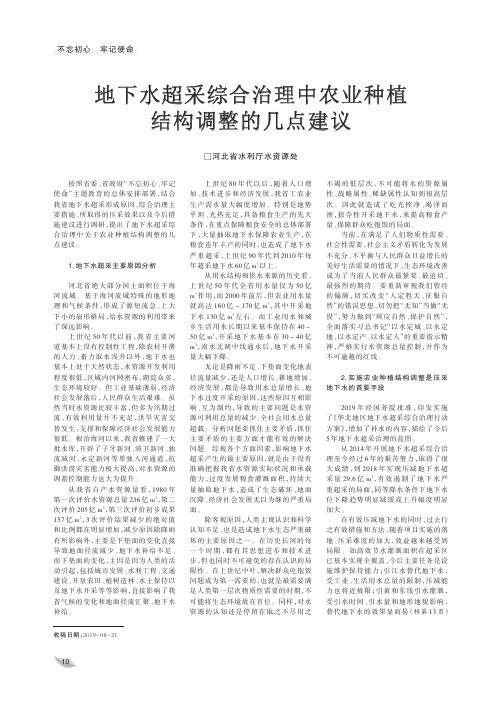
不忘初心牢记使命地下水超采综合治理中农业种植结构调整的几点建议□河北省水利厅水资源处收稿日期:2019-08-21按照省委、省政府“不忘初心、牢记使命”主题教育的总体安排部署,结合我省地下水超采形成原因、综合治理主要措施、所取得的压采效果以及今后措施建议进行调研,提出了地下水超采综合治理中关于农业种植结构调整的几点建议。
1.地下水超采主要原因分析河北省绝大部分国土面积位于海河流域。
基于海河流域特殊的地形地理和气候条件,形成了源短流急、上大下小的扇形格局,给水资源的利用带来了深远影响。
上世纪50年代以前,我省主要河道基本上没有控制性工程,除农村开凿的人力、畜力取水浅井以外,地下水也基本上处于天然状态,水资源开发利用程度很低,区域内河网密布,湖淀众多,生态环境较好。
但工业基础薄弱,经济社会发展落后,人民群众生活艰难。
虽然当时水资源比较丰富,但多为汛期过流,有效利用量并不充足,洪旱灾害交替发生,支撑和保障经济社会发展能力很低。
根治海河以来,我省修建了一大批水库,开辟了子牙新河、漳卫新河、独流减河、永定新河等单独入河通道,抗御洪涝灾害能力极大提高,对水资源的调蓄控制能力也大为提升。
从我省自产水资源量看,1980年第一次评价水资源总量236亿m 3,第二次评价205亿m 3,第三次评价初步成果157亿m 3,3次评价结果减少的绝对值和比例都在明显增加,减少原因除降雨有所影响外,主要是下垫面的变化直接导致地面径流减少、地下水补给不足。
而下垫面的变化,主因是因为人类的活动引起,包括城市发展、水利工程、交通建设、开垦农田、植树造林、水土保持以及地下水开采等等影响,直接影响了我省气候的变化和地面径流汇聚、地下水补给。
上世纪80年代以后,随着人口增加、技术进步和经济发展,我省工农业生产需水量大幅度增加。
特别是地势平坦、光热充足,具备粮食生产的先天条件,在重点保障粮食安全的总体部署下,大量抽取地下水保障农业生产,在粮食连年丰产的同时,也造成了地下水严重超采,上世纪90年代到2010年每年超采地下水60亿m 3以上。
河北省地下水超采区治理措施探讨

河北省地下水超采区治理措施探讨地下水作为重要的水资源之一,在我国河北省的经济社会发展中起着至关重要的作用。
然而,由于长期以来不合理的开采和管理,河北省的一些地区已经出现了严重的地下水超采问题,导致地下水水位逐渐下降,致使地表地质环境受到严重破坏,并对当地农业和生态系统造成了不可逆转的影响。
为此,河北省政府采取了一系列措施来治理地下水超采区,以实现地下水可持续利用。
一、建立严格的水资源管理制度首先,河北省政府应该在地下水超采区建立严格的水资源管理制度,通过制定相关政策法规和措施,明确地下水的开采对象、采取措施、管理机制等内容,加强对地下水开采单位的监管和管理。
同时,应该加强对违规开采地下水的处罚力度,以保护地下水资源的合理利用。
二、提高地下水资源利用效率为了减少地下水资源的损失和浪费,政府应该推广节水技术,鼓励农民和企业采用节水灌溉技术、节水设备和节水型生产线等措施,降低对地下水的依赖和开采量。
同时,应该加大对水资源利用效率的监测和监控力度,及时发现和纠正不合理利用的情况,提高地下水资源的利用效率。
三、加强水资源补给措施为了缓解地下水超采问题,政府应该加强水资源补给措施。
一方面,应该加大水库、大型水利工程和节水型灌区等建设投入,通过水资源调剂等措施增加地下水的补给量。
另一方面,应该加强人工补给技术的推广,包括地下水人工补给、雨水收集和再利用等措施,增加地下水的让水量。
四、加强地下水资源监测和管理为了更加有效地监控和管理地下水资源,政府应该加强水资源监测、管理和控制,要实现对地下水资源的实时监测和管理,并制定相关措施,及时发现和解决地下水超采问题。
五、加强治理工程建设最后,政府应该加强治理工程建设,开展针对地下水超采问题的实地研究和探讨,制定相应的治理方案。
治理工程建设应包括地下水人工补给设施、水资源调配设施、水库建设及河道改建等措施。
通过这些措施,可以去除超采区的症结,实现土地资源的可持续发展。
总之,地下水超采问题已经成为河北省经济和生态可持续发展的瓶颈之一。
河北省地下水超采区治理措施探讨
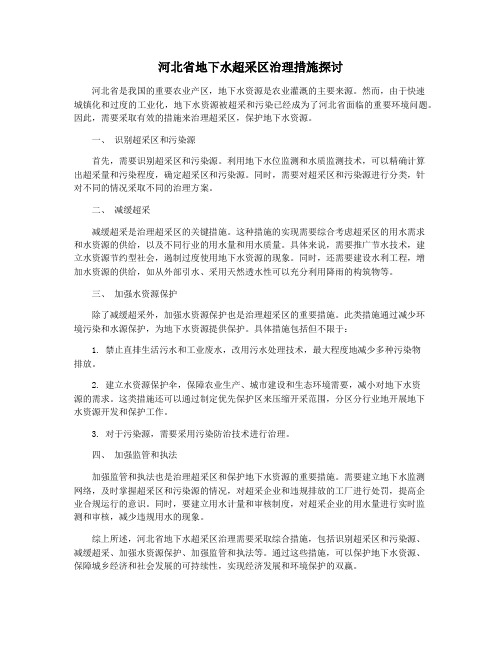
河北省地下水超采区治理措施探讨河北省是我国的重要农业产区,地下水资源是农业灌溉的主要来源。
然而,由于快速城镇化和过度的工业化,地下水资源被超采和污染已经成为了河北省面临的重要环境问题。
因此,需要采取有效的措施来治理超采区,保护地下水资源。
一、识别超采区和污染源首先,需要识别超采区和污染源。
利用地下水位监测和水质监测技术,可以精确计算出超采量和污染程度,确定超采区和污染源。
同时,需要对超采区和污染源进行分类,针对不同的情况采取不同的治理方案。
二、减缓超采减缓超采是治理超采区的关键措施。
这种措施的实现需要综合考虑超采区的用水需求和水资源的供给,以及不同行业的用水量和用水质量。
具体来说,需要推广节水技术,建立水资源节约型社会,遏制过度使用地下水资源的现象。
同时,还需要建设水利工程,增加水资源的供给,如从外部引水、采用天然透水性可以充分利用降雨的构筑物等。
三、加强水资源保护除了减缓超采外,加强水资源保护也是治理超采区的重要措施。
此类措施通过减少环境污染和水源保护,为地下水资源提供保护。
具体措施包括但不限于:1. 禁止直排生活污水和工业废水,改用污水处理技术,最大程度地减少多种污染物排放。
2. 建立水资源保护伞,保障农业生产、城市建设和生态环境需要,减小对地下水资源的需求。
这类措施还可以通过制定优先保护区来压缩开采范围,分区分行业地开展地下水资源开发和保护工作。
3. 对于污染源,需要采用污染防治技术进行治理。
四、加强监管和执法加强监管和执法也是治理超采区和保护地下水资源的重要措施。
需要建立地下水监测网络,及时掌握超采区和污染源的情况,对超采企业和违规排放的工厂进行处罚,提高企业合规运行的意识。
同时,要建立用水计量和审核制度,对超采企业的用水量进行实时监测和审核,减少违规用水的现象。
综上所述,河北省地下水超采区治理需要采取综合措施,包括识别超采区和污染源、减缓超采、加强水资源保护、加强监管和执法等。
通过这些措施,可以保护地下水资源、保障城乡经济和社会发展的可持续性,实现经济发展和环境保护的双赢。
河北省地下水超采区治理措施探讨

河北省地下水超采区治理措施探讨
地下水超采是指地下水的开采速度超过了地下水补给速度,导致地下水位下降、地下
水资源逐渐减少的现象。
河北省是我国地下水严重超采的地区之一,对于河北省地下水超
采区的治理非常重要。
本文将探讨河北省地下水超采区的治理措施。
要加强水资源管理。
要建立健全地下水资源管理系统,加强对地下水的监测、调查和
评价,及时了解地下水资源的状况。
在超采区要加强对地下水开采的管控,限制开采量,
确保地下水的可持续利用。
要加大对节水技术的宣传和推广力度。
要通过多种渠道向农村地区和居民普及水资源
节约利用的知识,提高人们对节水技术的认识和应用。
在农业生产方面,推广水肥一体化、滴灌、微喷等节水灌溉技术;在城市居民方面,鼓励安装节水器具、开展减少用水的宣传
活动。
要加强水资源的保护。
加大对地下水污染源的治理力度,建设污水处理站,治理农业
非点源污染,加强化肥农药的管理,防止其对地下水产生污染。
加强土地利用规划,避免
在地下水补给区建设高污染性的工业企业。
要加大科研力度,提高治理超采区的技术水平。
加强对地下水超采区水文地质条件的
研究,深入了解地下水的补给和排泄规律。
推进水资源调控工程的研究和建设,通过水库、灌溉渠道和水井等方式调节地下水位,增加地下水的储存量。
治理河北省地下水超采区需要加强水资源管理、加大对节水技术的宣传和推广力度、
加强水资源的保护以及加大科研力度等措施的综合应用。
只有通过各种措施的相互配合,
才能有效地治理地下水超采问题,保证地下水的可持续利用。
河北省地下水超采区治理措施探讨

河北省地下水超采区治理措施探讨近年来,随着河北省经济的快速发展和人口的持续增长,地下水资源的开发和利用已经超过了其再生能力,导致了地下水超采和地下水位下降等问题。
地下水超采引发了一系列环境和生态问题,对农田灌溉、城市供水、生态环境等产生了负面影响。
如何对河北省地下水超采区进行有效治理,成为了当下亟待解决的重要问题。
一、超采区的划定与评估河北省地下水超采区的划定主要依据地下水位下降速率、地下水资源补给、地下水开发利用情况、地下水质量变化等因素进行综合评估。
需要通过对地下水位变化的监测和分析,识别出地下水位下降较为严重的区域,层析出超采区范围。
对地下水资源的补给情况进行分析,了解超采区的地下水资源承载能力和再生能力。
通过对超采区的地下水开发利用情况和地下水质量的变化进行调查,进行超采区的评估和划定。
只有明确超采区的范围和程度,才能有针对性地制定治理措施。
二、科学合理的地下水管理针对地下水超采区,应优化和健全地下水资源管理制度,加强地下水资源的开发、利用和保护。
建立健全地下水资源调控机制,明确地下水开发利用的总量控制、分区分级管理,保障地下水资源的可持续利用。
加强对地下水开发利用的监测和管理,建立健全地下水资源调查和监测网络,及时掌握地下水开发利用的情况,保护地下水资源的合理开发和利用。
加强地下水资源的保护,加大执法力度,严厉打击违法采水行为,保障地下水资源的合理开发和利用。
三、推进农业节水灌溉技术农业是地下水超采的主要原因之一,推广和应用农业节水灌溉技术是治理地下水超采的重要途径。
应加大对农业灌溉水利设施的改造和建设,提高灌溉水利设施的效率和利用率。
推广高效节水灌溉技术,如滴灌、微喷灌等技术,减少农业用水量,降低对地下水的开采压力,保障农业生产的可持续发展。
四、发展替代水资源为了减缓地下水超采的压力,河北省应加大对替代水资源的开发和利用力度。
发展城市污水资源化利用,将城市污水经过处理后用于农田灌溉,减少对地下水的开采。
河北省地下水超采区治理措施探讨
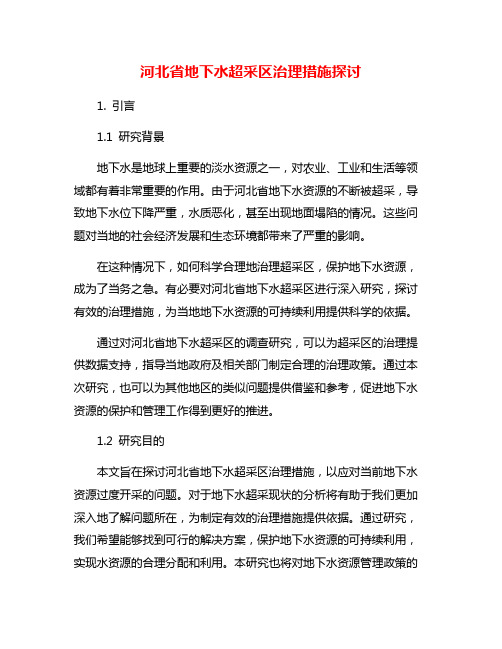
河北省地下水超采区治理措施探讨1. 引言1.1 研究背景地下水是地球上重要的淡水资源之一,对农业、工业和生活等领域都有着非常重要的作用。
由于河北省地下水资源的不断被超采,导致地下水位下降严重,水质恶化,甚至出现地面塌陷的情况。
这些问题对当地的社会经济发展和生态环境都带来了严重的影响。
在这种情况下,如何科学合理地治理超采区,保护地下水资源,成为了当务之急。
有必要对河北省地下水超采区进行深入研究,探讨有效的治理措施,为当地地下水资源的可持续利用提供科学的依据。
通过对河北省地下水超采区的调查研究,可以为超采区的治理提供数据支持,指导当地政府及相关部门制定合理的治理政策。
通过本次研究,也可以为其他地区的类似问题提供借鉴和参考,促进地下水资源的保护和管理工作得到更好的推进。
1.2 研究目的本文旨在探讨河北省地下水超采区治理措施,以应对当前地下水资源过度开采的问题。
对于地下水超采现状的分析将有助于我们更加深入地了解问题所在,为制定有效的治理措施提供依据。
通过研究,我们希望能够找到可行的解决方案,保护地下水资源的可持续利用,实现水资源的合理分配和利用。
本研究也将对地下水资源管理政策的调整和优化提供参考,为地下水资源的保护和可持续利用做出贡献。
通过深入分析和探讨,我们希望能够为解决河北省地下水超采问题提供有效的方案,推动地下水资源的可持续利用,实现生态文明建设和可持续发展的目标。
1.3 研究意义地下水是人类重要的水资源之一,也是我国农业、工业和生活用水的重要来源。
随着人口的增长和经济的发展,地下水资源的开采量逐渐增加,导致了部分地区地下水超采现象的严重加剧。
河北省作为我国重要的农业生产基地之一,地下水超采问题日益突出,已经成为制约当地可持续发展的一个重要因素。
对河北省地下水超采区进行治理,不仅能够保护地下水资源,维护生态环境,也可以保障农田灌溉和城市供水的需求。
研究河北省地下水超采区的治理措施具有重要的意义。
通过深入分析超采现状,并探讨有效的治理措施,可以为相关部门制定科学合理的政策提供参考依据,促进地下水资源的可持续利用,实现经济社会的可持续发展。
河北省地下水超采区治理措施探讨

河北省地下水超采区治理措施探讨随着经济的发展和城市化的加速,地下水超采问题日益严重,强烈的需求和无节制的开采给水资源造成了巨大的破坏,特别是在干旱缺水的北方省份更加明显。
近年来,河北省政府为了解决地下水超采问题,采取了一系列有效的治理措施,取得了一定成效。
本文将对河北省地下水超采区治理措施进行探讨。
一、加强监管政府应该在整个地下水超采治理体系中中心地位,规章制度的制定和实施应该切实可行。
应该加大督查和检查力度,加强地下水超采的监管和整治工作,并加强对超采企业的监管和管理。
此外还应该加强信息公开和公开透明,加强对社会的宣传和教育,提高对地下水超采的认识和保护意识。
二、采用科学技术手段政府应该采用科学技术手段来解决地下水超采问题。
首先,可以采用地下水均衡管理方法,促进水资源的均衡利用,探索多元化的水资源管理模式,以实现对地下水超采的精确控制。
其次,可以采用技术手段,如地下水开发、水井变更、控制排水等,通过技术手段减少地下水损失,提高水资源利用效率。
同时,政府应该推广新的节水技术和设备,提高人员培训和技术水平,开展科学研究和技术创新,推动节约型、环保型的新型工业和农业的发展。
三、鼓励节水的生产及正能量政府可以通过制定政策鼓励生产者使用节约水的技术,引导市场逐步地适应更加环保、经济的发展方式。
政府可以采取税收优惠、补贴等措施,鼓励企业改进技术,采用环保型、节约型的生产方式,提高生产节水的积极性。
同时,政府应该加强对市场的监管,要求商家在生产和销售过程中使用节约水的技术,并在商品的标签上标注该产品生产过程中消耗的水量和节水效果。
四、加强管理和宣传治理地下水超采问题需要全民共同参与,政府应该加强对地下水超采问题的宣传和教育,让公众了解地下水超采造成的危害和改善的必要性,引导公众从自身做起,加强对地下水资源的保护意识,促进社会全面关注和支持地下水超采治理工作。
同时,应该加强与公众的沟通,听取公众的意见和建议,并及时反馈。
河北省地下水超采区治理措施探讨
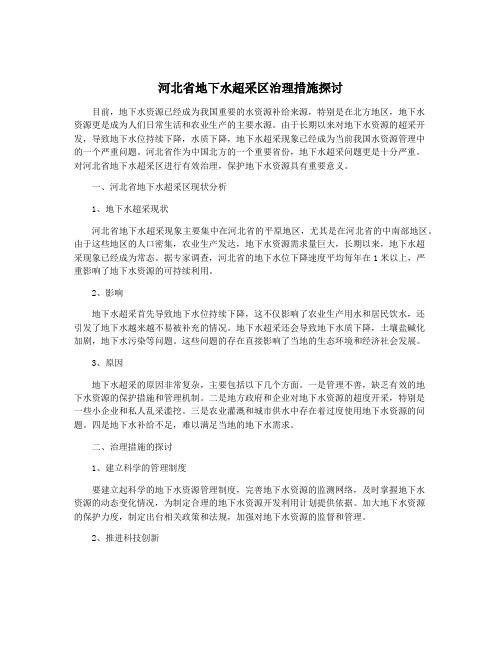
河北省地下水超采区治理措施探讨目前,地下水资源已经成为我国重要的水资源补给来源,特别是在北方地区,地下水资源更是成为人们日常生活和农业生产的主要水源。
由于长期以来对地下水资源的超采开发,导致地下水位持续下降,水质下降,地下水超采现象已经成为当前我国水资源管理中的一个严重问题。
河北省作为中国北方的一个重要省份,地下水超采问题更是十分严重。
对河北省地下水超采区进行有效治理,保护地下水资源具有重要意义。
一、河北省地下水超采区现状分析1、地下水超采现状河北省地下水超采现象主要集中在河北省的平原地区,尤其是在河北省的中南部地区。
由于这些地区的人口密集,农业生产发达,地下水资源需求量巨大,长期以来,地下水超采现象已经成为常态。
据专家调查,河北省的地下水位下降速度平均每年在1米以上,严重影响了地下水资源的可持续利用。
2、影响地下水超采首先导致地下水位持续下降,这不仅影响了农业生产用水和居民饮水,还引发了地下水越来越不易被补充的情况。
地下水超采还会导致地下水质下降,土壤盐碱化加剧,地下水污染等问题。
这些问题的存在直接影响了当地的生态环境和经济社会发展。
3、原因地下水超采的原因非常复杂,主要包括以下几个方面。
一是管理不善,缺乏有效的地下水资源的保护措施和管理机制。
二是地方政府和企业对地下水资源的超度开采,特别是一些小企业和私人乱采滥挖。
三是农业灌溉和城市供水中存在着过度使用地下水资源的问题。
四是地下水补给不足,难以满足当地的地下水需求。
二、治理措施的探讨1、建立科学的管理制度要建立起科学的地下水资源管理制度,完善地下水资源的监测网络,及时掌握地下水资源的动态变化情况,为制定合理的地下水资源开发利用计划提供依据。
加大地下水资源的保护力度,制定出台相关政策和法规,加强对地下水资源的监督和管理。
2、推进科技创新科技是治理地下水超采问题的有效手段。
需要积极推进科技创新,加大对地下水资源的勘测与评价工作,利用遥感技术和地下水模拟技术等手段,全面了解地下水资源的分布和储量情况,确保地下水资源的合理利用。
河北省地下水超采区治理措施探讨

河北省地下水超采区治理措施探讨1. 引言1.1 河北省地下水超采问题简介河北省是中国北方重要的农业大省,地下水资源在农业灌溉和城市生活中起着至关重要的作用。
长期以来,河北省地下水资源遭受严重超采的问题。
随着经济发展和人口增加,地下水开采量持续增加,导致地下水位下降、地表塌陷等问题日益严重。
据统计,河北省目前已有多个地下水超采区,其中主要集中在雄安新区、石家庄、保定等地。
超采严重影响了地下水系统的平衡和生态环境的稳定,也加剧了地下水质量的下降和土地沙漠化的加剧。
针对这一问题,亟需采取有效的措施加以治理,保护河北省的地下水资源,确保生态环境的持续健康发展。
2. 正文2.1 超采区现状分析河北省是我国地下水资源丰富的省份之一,然而长期以来,由于过度开采和管理不善,导致了部分地区出现了地下水超采问题。
超采区主要集中在河北省的北部和东部地区,包括石家庄、保定、邯郸、邢台等市县。
这些地区地下水位持续下降,地下水资源逐渐枯竭,已经严重影响到当地的农业灌溉、工业生产和城市生活用水。
超采区的形成主要是由于地下水开采量大于地下水补给量,导致地下水水位下降。
除了自然因素外,人为因素也是导致超采问题的重要原因之一。
长期的过度开采、侵占水源保护区和未经合理补给的地下水开采行为,加剧了超采问题的恶化。
超采区的出现也会引发一系列的环境问题,如地下水质量恶化、土壤盐碱化、地表下陷等。
这些问题不仅会影响当地的生态环境和可持续发展,也会给人们的生活带来诸多困扰。
加强对超采区的现状分析,找出问题的根源,并制定合理有效的治理措施,是当前河北省地下水治理工作的紧迫任务。
2.2 超采区治理措施探讨超采区治理是保障地下水资源可持续利用的关键环节。
针对河北省地下水超采问题,采取有效的治理措施至关重要。
应加强监测和评估工作,及时掌握超采区的情况,为制定科学有效的治理方案提供依据。
可以通过减少地下水开采量来控制超采现象。
这可以通过严格的配额管理和管控机制来实现。
沧州市地下水超采综合治理存在的问题及对策
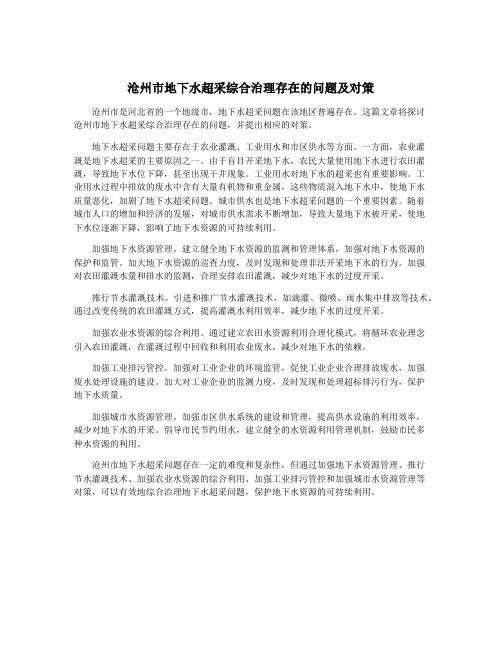
沧州市地下水超采综合治理存在的问题及对策沧州市是河北省的一个地级市,地下水超采问题在该地区普遍存在。
这篇文章将探讨沧州市地下水超采综合治理存在的问题,并提出相应的对策。
地下水超采问题主要存在于农业灌溉、工业用水和市区供水等方面。
一方面,农业灌溉是地下水超采的主要原因之一。
由于盲目开采地下水,农民大量使用地下水进行农田灌溉,导致地下水位下降,甚至出现干井现象。
工业用水对地下水的超采也有重要影响。
工业用水过程中排放的废水中含有大量有机物和重金属,这些物质混入地下水中,使地下水质量恶化,加剧了地下水超采问题。
城市供水也是地下水超采问题的一个重要因素。
随着城市人口的增加和经济的发展,对城市供水需求不断增加,导致大量地下水被开采,使地下水位逐渐下降,影响了地下水资源的可持续利用。
加强地下水资源管理。
建立健全地下水资源的监测和管理体系,加强对地下水资源的保护和监管。
加大地下水资源的巡查力度,及时发现和处理非法开采地下水的行为。
加强对农田灌溉水量和排水的监测,合理安排农田灌溉,减少对地下水的过度开采。
推行节水灌溉技术。
引进和推广节水灌溉技术,如滴灌、微喷、雨水集中排放等技术。
通过改变传统的农田灌溉方式,提高灌溉水利用效率,减少地下水的过度开采。
加强农业水资源的综合利用。
通过建立农田水资源利用合理化模式,将循环农业理念引入农田灌溉,在灌溉过程中回收和利用农业废水,减少对地下水的依赖。
加强工业排污管控。
加强对工业企业的环境监管,促使工业企业合理排放废水,加强废水处理设施的建设。
加大对工业企业的监测力度,及时发现和处理超标排污行为,保护地下水质量。
加强城市水资源管理。
加强市区供水系统的建设和管理,提高供水设施的利用效率,减少对地下水的开采。
倡导市民节约用水,建立健全的水资源利用管理机制,鼓励市民多种水资源的利用。
沧州市地下水超采问题存在一定的难度和复杂性,但通过加强地下水资源管理、推行节水灌溉技术、加强农业水资源的综合利用、加强工业排污管控和加强城市水资源管理等对策,可以有效地综合治理地下水超采问题,保护地下水资源的可持续利用。
浅谈河北地下水资源开采情况及引发的灾害

河北省地下水资源超采的主要原因
一、为保证粮食、蔬菜供应而扩大有效灌溉面积 造成的。 二、经济社会的发展、人民生活水平的提高需水 量增加造成的。
由于地下水大量超采,造 成一系列生态环境问题。据统 计,河北省每年因地下水位下 降.出水量减少造成机井报废、 机泵换代、效率降低、能耗增 加等形成的直接损失约22亿元。 1989--1999年河北省平原地面 沉降大于200mm的面积已达 42120km.大于300mm的面积已 达18718km .大于500mm的面积 达6430km.主要沉降中心的地 面沉降速率达34.9~131.5mm/ a。短短几年.由于地下水资源 超采而造成河北邢台等地3市5 县出现大地裂缝,最长的柏乡 大裂缝长达8km。
五个主要地裂区
河北柏乡地裂1
河北柏乡地裂2
地下水超采引起的地质灾害问题
2、地下水环境的污染
一 、 工 农 业 的 “ 飞 速 ” 发 展
二 、 生 活 污 水 的 大 量 排 放
地下水资源可持续开发利用的措施
河北省水资源缺乏,在工农业 和 城市又需要大量水资源,因过量开采 已经造成了众多的地质灾害,在这现 实矛盾的情况下,为了可以持续利用 地下水作为社会经济发展的支撑,应 采取以下几个方面的措施 :
目前,河北省主要河流全部修建了 控制性的工程.平水年各河流来水 的95%已被省内1160多座大中小型 水库控制.供水保障率得到了明显 提高。但是,随着经济发展、人口 增加和有效灌溉面积的不断扩大, 全省的总用水量由20世纪80年代的 l00多亿m3,急剧增加到目前220亿 m3。河北省每年还要将196亿m3水无 偿调给京津河北省只能靠抽取地下 水来维持经济社会的发展。目前, 全省现有灌溉机井90多万眼,每年 开采地下水150亿m3。年超采地下水 26亿--95亿m3。
沧州市地下水超采综合治理存在的问题及对策

沧州市地下水超采综合治理存在的问题及对策沧州市位于河北省中部,是全国重要的农业和工业基地之一。
由于长期存在的地下水超采问题,沧州市地下水资源面临枯竭和污染的风险。
本文将分析沧州市地下水超采存在的问题,并提出相应的对策。
沧州市地下水超采问题严重影响了农业和工业生产。
地下水是沧州市农业生产的重要水源,农田灌溉需要大量的地下水供给。
由于地下水超采,农田灌溉所需的水量无法得到满足,导致农作物生产受到严重影响。
地下水也是工业生产的重要用水来源,许多企业依赖地下水进行生产活动。
地下水超采造成了地下水位下降,企业无法获得足够的地下水供给,严重制约了工业生产的发展。
地下水超采还引发了地质灾害的风险。
地下水过量开采导致地下水位下降,使得地下水与地下岩层接触面积增大,进而导致地下岩层变得松散易溶解。
在地质条件较差的地区,地下岩层容易溶解塌陷,造成地面塌陷等灾害。
对于沧州市来说,由于地下水超采,地质灾害的风险大大增加,给人民生命财产安全带来了严重威胁。
地下水超采还引发了水源污染的问题。
地下水的超采会导致地下水位下降,使得地下水与地表水相互渗透,进而导致地表水中的污染物进入地下水系统。
地下水的超采还会造成地下水回补速度的减缓,使得地下水中的污染物被稀释的速度变慢,导致地下水的水质恶化。
由于地下水是人类饮用水的重要来源,地下水超采引发的水源污染问题不容忽视。
针对沧州市地下水超采存在的问题,应采取以下对策。
要加强地下水资源的管理和监管。
建立健全地下水开采许可制度,对地下水的开采进行严格限制,合理分配地下水资源。
加强对地下水超采行为的打击和惩罚,提高违法开采地下水的成本,倒逼企业和农民合理使用地下水资源。
要推广节水技术和设施,减少对地下水的依赖。
加大水资源的合理利用力度,提高农田灌溉的水利效率。
对于工业企业,通过引入先进的生产设备和节水技术,减少对地下水的使用量。
还可以加大对农田灌溉和工业用水的监测和管理力度,确保水资源的科学合理利用。
沧州市地下水超采综合治理存在的问题及对策

沧州市地下水超采综合治理存在的问题及对策沧州市位于河北省的中部地区,其地下水资源在该地区的农业生产、工业用水和居民生活中起着重要的作用。
近年来,由于地下水的超采取行为日益严重,导致地下水位下降,水质恶化,已经引起了广泛的关注。
本文旨在分析沧州市地下水超采综合治理存在的问题,并提出相应的对策。
地下水超采的主要原因是缺乏有效的立法和监管机制。
目前,我国地下水管理的法律法规体系尚不完善,缺乏明确的责任分工和监管机构,导致地下水超采行为得不到有效的约束和惩罚。
地方政府在地下水管理方面也存在监管不到位的问题,一些地方政府在追求经济增长和税收收入的对地下水超采问题缺乏足够的重视和监管。
地下水超采也与农业生产、工业用水和居民生活方式密切相关。
由于农田灌溉水利用率低、农业用水管理不规范等原因,农业生产对地下水的超采贡献较大。
工业领域对地下水资源的开采也较为频繁,一些企业未能有效节约用水,导致地下水超采。
一些居民在生活用水方面存在浪费现象,也加剧了地下水超采的问题。
地下水超采对生态环境造成了严重的影响。
地下水位下降导致了地表水和土壤干燥程度的增加,影响了生态系统的平衡,导致土地退化和生物多样性的减少。
地下水超采还可能引发地下水污染,从而对人类健康产生潜在威胁。
针对以上问题,下面提出以下对策:加强立法和监管。
加强地下水资源管理的立法工作,建立健全地下水超采的监管机制,明确各级政府和有关部门的责任和权限,加大对地下水超采行为的处罚力度,提高违法成本,形成有效的约束机制。
改善农业生产、工业用水和居民生活方式。
加强农业用水管理,提高灌溉水利用效率,推广节水灌溉技术,减少农业对地下水的超采贡献。
加强工业用水管理,推动企业节约用水,加大水资源回收和再利用的力度。
加强居民节水宣传教育,提高居民节约用水意识,减少生活用水浪费。
加强生态环境保护。
加强地下水和地表水的综合管理,促进水资源的合理配置和利用。
加大水环境保护力度,加强水源地保护和水体监测,加强地下水保护区的建设,防止地下水污染。
河北省地下水超采区治理措施探讨
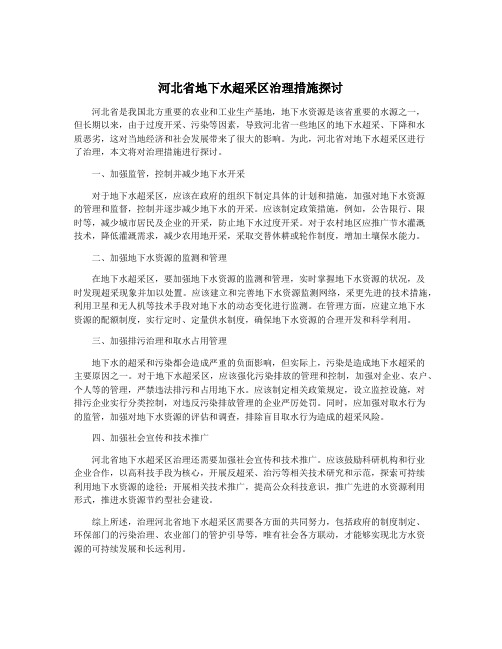
河北省地下水超采区治理措施探讨河北省是我国北方重要的农业和工业生产基地,地下水资源是该省重要的水源之一,但长期以来,由于过度开采、污染等因素,导致河北省一些地区的地下水超采、下降和水质恶劣,这对当地经济和社会发展带来了很大的影响。
为此,河北省对地下水超采区进行了治理,本文将对治理措施进行探讨。
一、加强监管,控制并减少地下水开采对于地下水超采区,应该在政府的组织下制定具体的计划和措施,加强对地下水资源的管理和监督,控制并逐步减少地下水的开采。
应该制定政策措施,例如,公告限行、限时等,减少城市居民及企业的开采,防止地下水过度开采。
对于农村地区应推广节水灌溉技术,降低灌溉需求,减少农用地开采,采取交替休耕或轮作制度,增加土壤保水能力。
二、加强地下水资源的监测和管理在地下水超采区,要加强地下水资源的监测和管理,实时掌握地下水资源的状况,及时发现超采现象并加以处置。
应该建立和完善地下水资源监测网络,采更先进的技术措施,利用卫星和无人机等技术手段对地下水的动态变化进行监测。
在管理方面,应建立地下水资源的配额制度,实行定时、定量供水制度,确保地下水资源的合理开发和科学利用。
三、加强排污治理和取水占用管理地下水的超采和污染都会造成严重的负面影响,但实际上,污染是造成地下水超采的主要原因之一。
对于地下水超采区,应该强化污染排放的管理和控制,加强对企业、农户、个人等的管理,严禁违法排污和占用地下水。
应该制定相关政策规定,设立监控设施,对排污企业实行分类控制,对违反污染排放管理的企业严厉处罚。
同时,应加强对取水行为的监管,加强对地下水资源的评估和调查,排除盲目取水行为造成的超采风险。
四、加强社会宣传和技术推广河北省地下水超采区治理还需要加强社会宣传和技术推广。
应该鼓励科研机构和行业企业合作,以高科技手段为核心,开展反超采、治污等相关技术研究和示范,探索可持续利用地下水资源的途径;开展相关技术推广,提高公众科技意识,推广先进的水资源利用形式,推进水资源节约型社会建设。
沧州市地下水超采综合治理存在的问题及对策
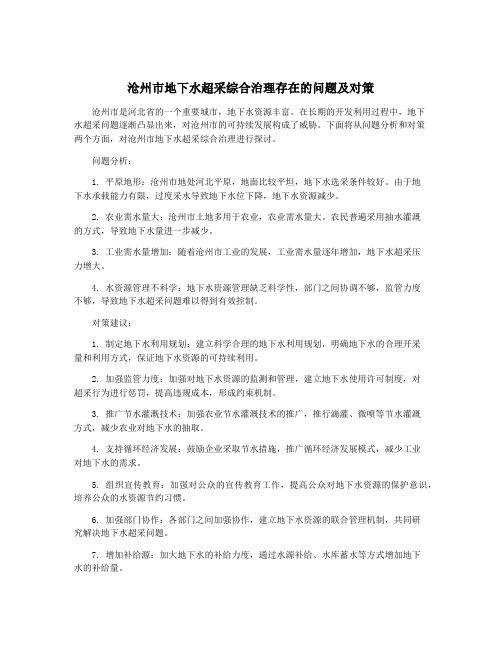
沧州市地下水超采综合治理存在的问题及对策沧州市是河北省的一个重要城市,地下水资源丰富。
在长期的开发利用过程中,地下水超采问题逐渐凸显出来,对沧州市的可持续发展构成了威胁。
下面将从问题分析和对策两个方面,对沧州市地下水超采综合治理进行探讨。
问题分析:1. 平原地形:沧州市地处河北平原,地面比较平坦,地下水选采条件较好。
由于地下水承载能力有限,过度采水导致地下水位下降,地下水资源减少。
2. 农业需水量大:沧州市土地多用于农业,农业需水量大。
农民普遍采用抽水灌溉的方式,导致地下水量进一步减少。
3. 工业需水量增加:随着沧州市工业的发展,工业需水量逐年增加,地下水超采压力增大。
4. 水资源管理不科学:地下水资源管理缺乏科学性,部门之间协调不够,监管力度不够,导致地下水超采问题难以得到有效控制。
对策建议:1. 制定地下水利用规划:建立科学合理的地下水利用规划,明确地下水的合理开采量和利用方式,保证地下水资源的可持续利用。
2. 加强监管力度:加强对地下水资源的监测和管理,建立地下水使用许可制度,对超采行为进行惩罚,提高违规成本,形成约束机制。
3. 推广节水灌溉技术:加强农业节水灌溉技术的推广,推行滴灌、微喷等节水灌溉方式,减少农业对地下水的抽取。
4. 支持循环经济发展:鼓励企业采取节水措施,推广循环经济发展模式,减少工业对地下水的需求。
5. 组织宣传教育:加强对公众的宣传教育工作,提高公众对地下水资源的保护意识,培养公众的水资源节约习惯。
6. 加强部门协作:各部门之间加强协作,建立地下水资源的联合管理机制,共同研究解决地下水超采问题。
7. 增加补给源:加大地下水的补给力度,通过水源补给、水库蓄水等方式增加地下水的补给量。
解决沧州市地下水超采问题需要各方面的共同努力。
只有在科学规划、严格管理、节水措施、公众参与等多方面综合治理的基础上,才能实现地下水资源的可持续利用,促进沧州市的可持续发展。
河北:探寻地下水超采综合治理的路径

河北:探寻地下水超采综合治理的路径地下水,对于河北来讲,一直是个沉重的话题。
由于多年超采,燕赵大地之下,已经暗藏着6.7万平方公里的地下水超采区,形成了26个地下水位降落漏斗!目前,华北平原已经成为世界上最大的“漏斗区”。
从某种意义上讲,深层地下水是一种不可再生的资源,是我们乃至子孙赖以生存的命脉,地下水超采治理已经到了刻不容缓的地步。
调整种植结构、大力利用坑塘、关停各类自备井……河北省部分地区已经开始进行了有益探索。
少用地下水——小麦、玉米变苜蓿、花生等,靠调整种植结构,一年可省出12个西湖8月19日,秋阳高照,在衡水景县龙华镇贾吕村苜蓿种植基地,繁茂的紫花苜蓿到了收获的季节。
在这里,笔者并没有见到北方常见的秋季农作物玉米。
原来,这里的农民改变了延续千百年的传统种植模式,不再种植需水量大的小麦、玉米,改为种植紫花苜蓿、饲用玉米等耐旱节水作物,并配备了数十套大型时针式喷灌设施和移动式喷灌设施进行喷灌。
“与小麦相比,每亩苜蓿年均能节水近200立方米。
”贾吕村党支部书记贾连海告诉笔者,一年下来,这些地可节水数十万立方米。
贾连海表示,小麦是“吃水大户”,冬小麦在生长周期内需要3至4次的灌溉。
农业用水占社会总用水量的70%以上,小麦又占农业用水量的近70%。
改变种植结构,就是改变了用水的结构。
这为河北省减少地下水的超采提供了新思路。
原先华北平原的作物熟制是两年三熟,新中国成立后,为了提高粮食产量,变更为一年两熟:一季小麦,一季玉米。
而要满足农业生产,只有大量开采地下水。
一个可以对比的数字是,河北人均水资源占有量仅占全国平均水平的1/7,河北的水资源总量仅为全国的0.7%,但却生产了全国6%的粮食,养育了占全国5%的人口。
河北省水利科学研究院高级工程师郭永晨认为,河北的水资源禀赋已不适合种植耗水量大的作物,应以水定结构,建立与当地自然资源禀赋条件相适应的种植结构。
为此,河北省提出,在无地表水替代的深层地下水严重超采区,有计划、有步骤地进行农业种植结构调整,适当压减依靠地下水灌溉的冬小麦种植面积,改冬小麦、夏玉米一年两熟制,为种植玉米、棉花、花生、油葵、杂粮等农作物一年一熟制,实现“一季休耕、一季雨养”,改种玉米、棉花等低耗水农作物,鼓励改种青贮玉米、苜蓿等饲草作物,探索走出一条节水压采稳粮的农业种植结构调整之路。
沧州市地下水超采综合治理存在的问题及对策
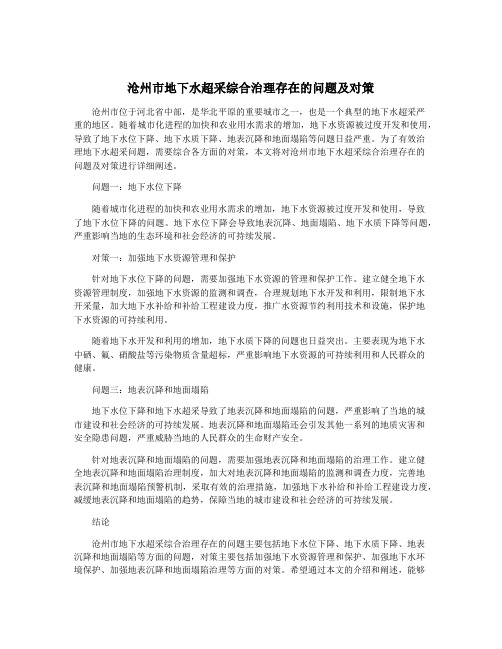
沧州市地下水超采综合治理存在的问题及对策沧州市位于河北省中部,是华北平原的重要城市之一,也是一个典型的地下水超采严重的地区。
随着城市化进程的加快和农业用水需求的增加,地下水资源被过度开发和使用,导致了地下水位下降、地下水质下降、地表沉降和地面塌陷等问题日益严重。
为了有效治理地下水超采问题,需要综合各方面的对策,本文将对沧州市地下水超采综合治理存在的问题及对策进行详细阐述。
问题一:地下水位下降随着城市化进程的加快和农业用水需求的增加,地下水资源被过度开发和使用,导致了地下水位下降的问题。
地下水位下降会导致地表沉降、地面塌陷、地下水质下降等问题,严重影响当地的生态环境和社会经济的可持续发展。
对策一:加强地下水资源管理和保护针对地下水位下降的问题,需要加强地下水资源的管理和保护工作。
建立健全地下水资源管理制度,加强地下水资源的监测和调查,合理规划地下水开发和利用,限制地下水开采量,加大地下水补给和补给工程建设力度,推广水资源节约利用技术和设施,保护地下水资源的可持续利用。
随着地下水开发和利用的增加,地下水质下降的问题也日益突出。
主要表现为地下水中硒、氟、硝酸盐等污染物质含量超标,严重影响地下水资源的可持续利用和人民群众的健康。
问题三:地表沉降和地面塌陷地下水位下降和地下水超采导致了地表沉降和地面塌陷的问题,严重影响了当地的城市建设和社会经济的可持续发展。
地表沉降和地面塌陷还会引发其他一系列的地质灾害和安全隐患问题,严重威胁当地的人民群众的生命财产安全。
针对地表沉降和地面塌陷的问题,需要加强地表沉降和地面塌陷的治理工作。
建立健全地表沉降和地面塌陷治理制度,加大对地表沉降和地面塌陷的监测和调查力度,完善地表沉降和地面塌陷预警机制,采取有效的治理措施,加强地下水补给和补给工程建设力度,减缓地表沉降和地面塌陷的趋势,保障当地的城市建设和社会经济的可持续发展。
结论沧州市地下水超采综合治理存在的问题主要包括地下水位下降、地下水质下降、地表沉降和地面塌陷等方面的问题,对策主要包括加强地下水资源管理和保护、加强地下水环境保护、加强地表沉降和地面塌陷治理等方面的对策。
河北地下水超采情势及种植结构调整对策的经济分析
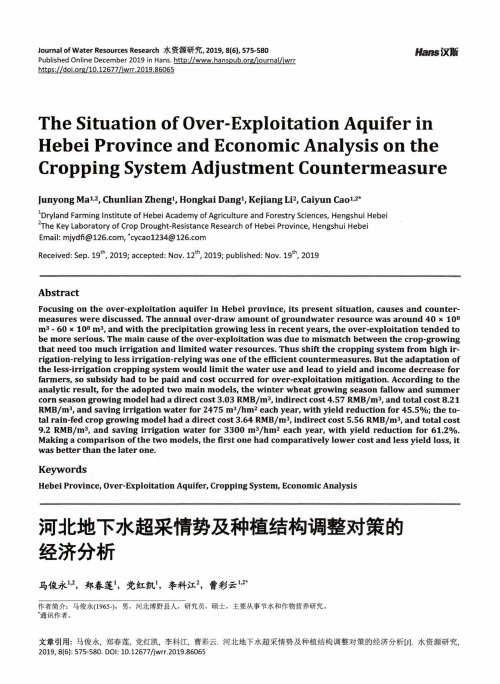
Journal of Water Resources Research水资源研究,2019,8(6),575-580HansiXlK Published Online December2019泊Hans,/iournal/iwrrhttps:///:L0.12677/iwrr.20:19.86065The Situation of Over-Exploitation Aquifer in Hebei Province and Economic Analysis on the Cropping System Adjustment Countermeasure Junyong Ma1*2,Chunlian Zheng1,Hongkai Dang1,Kejiang Li2,Caiyun Cao12*1Dryland Farming Institute of Hebei Academy of Agriculture and Forestry Sciences,Hengshui Hebei2The Key Laboratory of Crop Drought-Resistance Research of Hebei Province,Hengshui HebeiEmail:mjydfi@,'cycaol234@Received:Sep.19th,2019;accepted:Nov.12th,2019;published:Nov.19th,2019AbstractFocusing on the over-exploitation aquifer in Hebei province,its present situation,causes and countermeasures were discussed・The annual over-draw amount of groundwater resource was around40x108 m3・60x108m3,and with the precipitation growing less in recent years,the over-exploitation tended to be more serious・The main cause of the over-exploitation was due to mismatch between the crop-growing that need too much irrigation and limited water resources・Thus shift the cropping system from high irrigation-relying to less irrigation-relying was one of the efficient countermeasures・But the adaptation of the less-irrigation cropping system would limit the water use and lead to yield and income decrease for farmers,so subsidy had to be paid and cost occurred for over-exploitation mitigation.According to the analytic result,for the adopted two main models,the winter wheat growing season fallow and summer corn season growing model had a direct cost3.03RMB/m3,indirect cost4.57RMB/m3,and total cost8.21 RMB/m3,and saving irrigation water for2475m3/hm2each year,with yield reduction for45.5%;the total rain-fed crop growing model had a direct cost3.64RMB/m3,indirect cost5.56RMB/m3,and total cost 9.2RMB/m3,and saving irrigation water for3300m3/hm2each year,with yield reduction for61.2%. Making a comparison of the two models,the first one had comparatively lower cost and less yield loss,it was better than the later one・KeywordsHebei Province,Over-Exploitation Aquifer,Cropping System,Economic Analysis河北地下水超采情势及种植结构调整对策的经济分析马俊永郑春莲】,党红凯I,李科江2,曹彩云I,"作者简介:马俊永(1965・),男,河北博野县人,研究员,硕士,主要从事节水和作物营养研究。
- 1、下载文档前请自行甄别文档内容的完整性,平台不提供额外的编辑、内容补充、找答案等附加服务。
- 2、"仅部分预览"的文档,不可在线预览部分如存在完整性等问题,可反馈申请退款(可完整预览的文档不适用该条件!)。
- 3、如文档侵犯您的权益,请联系客服反馈,我们会尽快为您处理(人工客服工作时间:9:00-18:30)。
Journal of Water Resources Research 水资源研究, 2019, 8(6), 575-580Published Online December 2019 in Hans. /journal/jwrrhttps:///10.12677/jwrr.2019.86065The Situation of Over-Exploitation Aquifer in Hebei Province and Economic Analysis on the Cropping System Adjustment Countermeasure Junyong Ma1,2, Chunlian Zheng1, Hongkai Dang1, Kejiang Li2, Caiyun Cao1,2*1Dryland Farming Institute of Hebei Academy of Agriculture and Forestry Sciences, Hengshui Hebei2The Key Laboratory of Crop Drought-Resistance Research of Hebei Province, Hengshui HebeiReceived: Sep. 19th, 2019; accepted: Nov. 12th, 2019; published: Nov. 19th, 2019AbstractFocusing on the over-exploitation aquifer in Hebei province, its present situation, causes and counter-measures were discussed. The annual over-draw amount of groundwater resource was around 40 × 108 m3 - 60 × 108 m3, and with the precipitation growing less in recent years, the over-exploitation tended to be more serious. The main cause of the over-exploitation was due to mismatch between the crop-growing that need too much irrigation and limited water resources. Thus shift the cropping system from high ir-rigation-relying to less irrigation-relying was one of the efficient countermeasures. But the adaptation of the less-irrigation cropping system would limit the water use and lead to yield and income decrease for farmers, so subsidy had to be paid and cost occurred for over-exploitation mitigation. According to the analytic result, for the adopted two main models, the winter wheat growing season fallow and summer corn season growing model had a direct cost 3.03 RMB/m3, indirect cost 4.57 RMB/m3, and total cost 8.21 RMB/m3, and saving irrigation water for 2475 m3/hm2 each year, with yield reduction for 45.5%; the to-tal rain-fed crop growing model had a direct cost 3.64 RMB/m3, indirect cost 5.56 RMB/m3, and total cost 9.2 RMB/m3, and saving irrigation water for 3300 m3/hm2each year, with yield reduction for 61.2%. Making a comparison of the two models, the first one had comparatively lower cost and less yield loss, it was better than the later one.KeywordsHebei Province, Over-Exploitation Aquifer, Cropping System, Economic Analysis河北地下水超采情势及种植结构调整对策的经济分析马俊永1,2,郑春莲1,党红凯1,李科江2,曹彩云1,2*作者简介:马俊永(1965-),男,河北博野县人,研究员,硕士,主要从事节水和作物营养研究。
*通讯作者。
河北地下水超采情势及种植结构调整对策的经济分析1河北省农林科学院旱作农业研究所,河北 衡水 2河北省农作物抗旱研究重点试验室,河北 衡水收稿日期:2019年9月19日;录用日期:2019年11月12日;发布日期:2019年11月19日摘要针对河北省地下水超采漏斗问题,对当前地下水超采的情势、成因、对策等进行了分析。
河北省常年地下水超采量40~60亿m 3,近年随降雨量减少,超采呈增加趋势。
地下水超采主要原因之一是高耗水作物种植与水资量不匹配造成,因此与水资源量相匹配的种植结构调整是治理超采的有效措施之一。
但推行限水种植制度会不同程度造成粮食产量和农民收益降低,因此需要生态补偿和产生治理成本。
分析结果表明,目前推行的两种节水种植模式中,一季休耕一季雨养模式直接治理成本为3.03元/m 3,间接成本4.57元/m 3,综合成本8.21元/m 3,每a 节约灌溉水2475 m 3/hm 2,同时造成周年粮食减产45.5%;完全雨养旱作模式直接治理成本为3.64元/m 3,间接成本5.56元/m 3,综合成本9.2元/m 3,每a 可节约灌溉水3300 m 3/hm 2同时造成周年粮食减产61.2%。
两种治理模式比较,一季休闲一季雨养模式治理成本相对较低,并且粮食减产少。
关键词河北省,地下水超采漏斗,种植结构,经济分析Copyright © 2019 by author(s) and Wuhan University. This work is licensed under the Creative Commons Attribution International License (CC BY). /licenses/by/4.0/1. 河北省地下水超采现状与超采原因1.1. 地下水超采现状根据2003年开展的河北省水资源调查资料,河北省水资源总量204.7亿m 3,可利用水资源量约80%。
常年用水量200~220亿m 3,年水资源超用量40~60亿m 3 [1] [2]。
近年,随着全球气候变化,河北省降雨量呈现明显减少趋势,资料显示每10 a 减少7.6 mm [3],而河北平原地下水开采量呈一定增加趋势,70年代为88.0亿m 3、80年代为123.5亿m 3、90年代为122.3亿m 3、2000年为128.6亿m 3,2003年现状年河北平原深层地下水的开采为严重超采(TDS < 1 g/L),产生了水位降落漏斗[4],说明河北省的地下水超采量也呈现一定增加趋势。
于2014~2016年在河北省实施的地下水超采试点中,2013基准年全省年超采量达到59.6亿m 3,并以此作为超采治理的目标[5]。
近30a 全省已累计超采地下水1500亿m 3 [6],因此河北省地下水超采治理迫在眉睫。
1.2. 主要超采原因用水量与水资源禀赋不匹配的矛盾是河北省地下水超采的根本原因,由于河北省地表水资源十分匮乏,因此超用的主要是地下水,导致了地下水超采漏斗。
而工业和生活用水不断增加,发展灌溉及高耗水作物的种植,加剧了地下水超采漏斗的发展。
历史上河北省曾经是水资源相对比较丰富,以致于一些低洼地区还经常出现水患。
而历史上河北的黑龙港地区河道沟渠水比较多,地下水位较高,一直土壤盐碱较严重。
为了治水1963年毛主席发出“一定要根治海河”的号召。
随着山区水库建设和打井发展灌溉农业,粮食产量不断增加,但地下水位不断下降,地表水逐渐萎缩河北地下水超采情势及种植结构调整对策的经济分析消逝,地下水持续超采,诱发了大范围的地下水超采漏斗。
根据2016年水资源公报,农业用水比例占总用水量70.1%,其中灌溉用水占64.1% [7]。
河北省小麦种植面积约233万hm2 (3500万亩),河北省小麦的ET在400~450 mm,生长季节降雨只能满足总耗水量的1/4~1/3,其余需要灌溉来满足[8]。
而河北粮食生产的90%来自灌溉农业,因此大规模发展的灌溉农业是河北省地下水超采的重要原因之一。
另外随着人口增加,工业和生活用水增加也加剧了地下水超采。
2. 调整种植结构治理对策的经济分析灌溉农业在河北省用水结构的比例最大,因此调整种植结构,发展适水种植模式,建立与水资源承载力相匹配的种植制度是地下水超采治理的关键措施之一。
自2014~2016年在河北实施的地下水超采治理试点,轮作休耕发挥了比较好的作用。
目前“一季休耕,一季雨养”已经发展到13.3万hm2 (200万亩) [9]。
另外还小面积试点了封井纯雨养旱作模式。
鉴于这些模式与传统的小麦玉米一年两作种植模式相比,在灌溉和产出上有较大差异,并且需要不同的生态补偿成本。
因此下面以常规小麦玉米种植模式为对照,就不同模式的投入成本、节水效果和对粮食产量的影响进行系统分析,为节水种植制度和治理地下水超采提供理论借鉴。
目前河北省推广的种植制度调整治理超采模式主要有两种,一种是“一季雨养一季休耕”模式,即在常规的小麦玉米一年两作模式中,只种植一季玉米,小麦季节休闲,每hm2补贴7500元;一种是完全雨养旱作模式,即小麦玉米均不灌溉(封井),作物完全靠雨养,该模式每hm2补贴12,000元。
